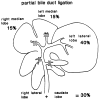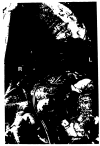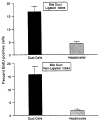Cell proliferation and oncogene expression after bile duct ligation in the rat: evidence of a specific growth effect on bile duct cells
- PMID: 7705781
- PMCID: PMC2963564
Cell proliferation and oncogene expression after bile duct ligation in the rat: evidence of a specific growth effect on bile duct cells
Abstract
The proliferative response of the rat liver was measured after temporary or permanent total biliary obstruction (BDO) and in different regions after selective ligation of the lobar ducts draining the right 60% of the hepatic mass. The results were compared with those after 70% partial hepatectomy (PH). Cell proliferation was assessed globally by measuring DNA synthesis and stratified to the separate cell populations with cytostaining techniques that allowed distinction of hepatocytes, duct cells, and nonparenchymal cells (NPCs). In selected experimental groups, gene expression was determined of transforming growth factor-beta 1 (TGF beta-1), prothrombin, c-erb-B2, transforming growth factor alpha (TGF alpha), human Cyclophilin (CyP), and 28S ribosomal RNA. The stimulation of a proliferative response to total BDO required obstruction for longer than 24 hours, but after this deligation did not switch off regeneration. In the first week after permanent BDO, there was progressive infiltration of NPCs, fibrous linkage of some portal areas, and a crescendo of DNA synthesis that was obvious at 24 hours, maximal at 48 hours, and back nearly to baseline at 6 days. At the 2-day mark, the bile duct cells had a 17-fold increase in proliferation, accompanied by a threefold to fourfold increase in hepatocyte renewal. Little or no increase in expression of TGF alpha or the hepatocyte-specific prothrombin gene was detectable in the first 48 hours, whereas levels of the oncogene c-erb-B2 that is associated with cholangiocarcinoma were expressed from 48 to 96 hours.(ABSTRACT TRUNCATED AT 250 WORDS)
Figures













References
-
- Accatino L, Contreras A, Fernandez S, Quintana C. The effect of complete biliary obstruction on bile flow and bile acid excretion: postcholestatic choleresis in the rat. J Lab Clin Med. 1979;93:706–717. - PubMed
-
- Slott PA, Liu MH, Tavoloni N. Origin, pattern and mechanism of bile duct proliferation following biliary obstruction in the rat. Gastroenterology. 1990;99:466–477. - PubMed
-
- Shibayama Y. Factors producing bile infarction and bile duct proliferation in biliary obstruction. J Pathol. 1990;160:57–62. - PubMed
Publication types
MeSH terms
Substances
Grants and funding
LinkOut - more resources
Full Text Sources
